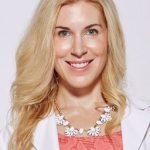An interview with Dr. Emily CEO / Founder of Naboso Technology and EBFA.

Dr. Emily Splichal
Doctor of Podiatric Medicine
Dr. Emily Splichal is a Podiatrist, Human Movement Specialist and Global Leader in Barefoot Science and Rehabilitation. Dr. Emily believes that we hold the power to our health and well-being in our hands. She has developed an eye for movement dysfunction and neuromuscular control during gait, her higher-level assessment skills allow for more detailed rehabilitation programming. WillKin values Dr Emily’s expertise and are pleased to be collaborating in the future. In the meantime, here is a wonderful interview to introduce her background, barefoot training and EBFA to Kinesiologists who are not yet familiar.
An interview with Dr. Emily CEO / Founder of Naboso Technology and EBFA
Q 1 : Tells us about your background, what did your journey look like up to now?
“I am a functional podiatrist, human movement specialist. I have been in the fitness industry for over 20 years. Within fitness, I am on the side of education and develop programming built around barefoot science, foot centred, and foot to core sequencing. I got into fitness and human movement from my background as a gymnast for 13 years.”
During her time in podiatry school, to specialize in medicine, she noticed a disconnect by the medical community, podiatry, in particular. She challenged what she was being taught through podiatry school. From her understanding of feet and foot science, she knew there was a greater impact she could be making. This is where she went back to school, to complete a master’s in Human Movement. In her master’s she studied barefoot science, had her first taste in the fascial system and neuroscience. These 3 specialties: fitness, her medical degree and her background in human movement shaped her career and how she sees her patients. This all led her to EBFA (Evidence Based Fitness Academy) and to Naboso, her product company. Naboso enhances barefoot stimulation, brain activation and movement pattern from a sensory perspective.
Q 2 : What brought you to barefoot training?
“I can’t pinpoint the exact thing that brought me to barefoot training. I have an appreciation for being barefoot because gymnastics is a barefoot sport. I also started teaching barefoot, just because I really liked being barefoot. This was before the boom of minimal running and the barefoot running boom.”
During her time on the conference circuit, she continually heard about minimal shoes and foot function from fitness specialists. She noticed that there were certain things at that time, that wasn’t painting a proper picture of foot function. Those teaching weren’t podiatrist with that background in podiatric medicine. This was where she saw the opportunity! This topic was hot and trendy! She came in with her background in podiatry and her credibility in educating people about this trendy topic, at that time. She became fascinated by seeing the results in her clients and from fitness professionals.
“I happened to be at the right place at the right time and I happened to be a podiatrist”
The timing was great, the trend was booming at that time. This opened up the career path. Now she sees barefoot training as a philosophy in human movement. Similar to myofascial release, which used to be trendy, it is now a constant and normal in fitness and movement.
“Now with barefoot science, I am normalizing it and trying to be the important role to make this happen. Making sure we are looking at the feet as a sensory gateway!”

Q 3 : Which type of professionals follow the EBFA platform?
There’s a big mix! All professions are on there and take the courses. From physiotherapists, athletic trainers, personal trainers, strength coaches, massage therapists, some podiatrists, yoga and pilates instructors. She mentions pilates is a large sector for EBFA. Pilates instructors have a great appreciation of deep core and the connection to feet. They especially love it when they talk about the pelvic floor!
Let’s not forget about the Kinesiologists! One of their master instructors is in Canada and is a Kinesiologist. Additionally, with the new partnership with WillKin, this is getting more and more Kins onto the EBFA platform.
Q 4 : What are you passionate about and what gets you through your day?
“I am passionate about movement and fascinated about the complexity of movement. I’m very curious and am constantly reading new research articles.”
Dr. Emily makes an analogy of the human body and movement control to having layers, like those of onions. “We are constantly peeling off layers and are finding ways of how the human body controls movement.” Her biggest interest and passion is the sensory side of the movement. This facet ties barefoot science with neuroscience greatly.
The testimonials and feedback that she gets from her patients, athletes and the end-users are what drive her daily! The feedback about integrating this philosophy, changing their lives, their movement, reducing their foot and back pain is motivation to herself, her education and towards Naboso.
Q 5 : Any new projects, you can talk about, coming to Naboso?
“We do have a couple of new products coming up, a new insole coming out!”
Dr. Emily mentioned their confirmed Canadian distributor. This will be an easier way that professionals and users in Canada to have access to the products. It is the same website, Naboso, redirecting to the Canadian site. Making shipping easier and no duties will be applied.
In addition to their product line, they constantly do pilots and research on their products. To see the new application and validity behind their products. This gets the confidence through the professionals and from the patients.

Q 6 : How has this current pandemic affected you?
“In prior years, roughly 70% of our revenue was from live workshops. Either myself or a master instructor taught these workshops around the world. This all dropped, unfortunately.”
Since there was an existing online platform, they started to shift towards this, and increase their online activity. As soon as COVID showed face, they strategically put prior live courses online. The courses still carry the same CEUs (continuing education credits). There has been growth since and people are taking to the online classes really well. The courses get to be completed on their own time, in their own home and in their own countries. She suggests supplementing the online course with live training when live workshops become available. Due to the nature of their courses, and the hands-on techniques, going to a live workshop will allow seeing subtleties that might be missed in the online courses.
Their goal through 2020, is to align themselves with companies, like WillKin, that have an online presence and network to get this message across.
Q 7 : Are you still seeing patients, do you have any time?
Before COVID she was seeing patients remotely, even patients in other parts of the world. She was doing telemedicine before the world was forced to shift to it. Her patients like it! It is easier on their schedules and the travel time is taken away. Dr. Emily still sees patients when she can, working her schedule around the 2 companies.
“I like to have one foot in the business and one foot in podiatry”
It is important for her to keep the connection with patients to see what they go through. Also, it’s important for her to be in the trenches to see what the professionals are going through and not to lose that aspect.
Discover the Naboso products : www.naboso.ca
Check out Evidence Based Fitness Academy : www.evidencebasedfitnessacademy.com

